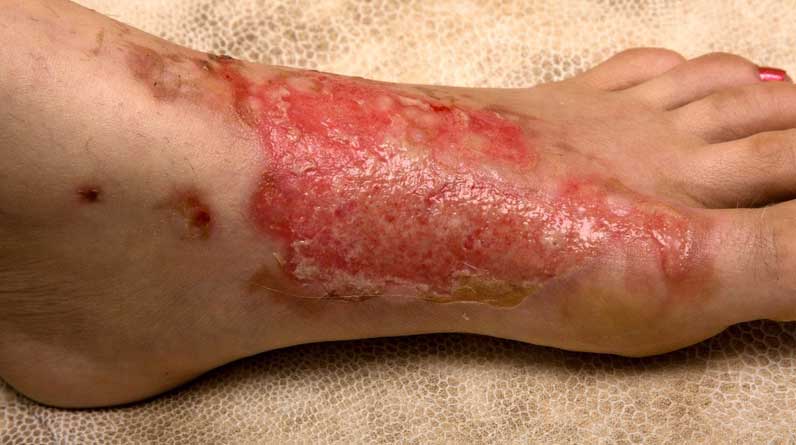
Burns and Injuries
Skin burns are some of the most painful injuries one can endure. While there is certainly a wide spectrum of skin burns and injuries that occur, all come with some level of pain which is often much more severe than other painful conditions.
Among children and adults, skin burns are some of the most common injuries due to the nature of our lifestyles involving activities such as cooking, bonfires, sunlight, and other electrical mechanisms used in our everyday lives.
Skin burns can also be caused by natural disasters, uncontrollable events, and workplace hazards, which makes their incidence even more common.
While most can recover from burns, major health complications can arise as a byproduct of the burn or burns, depending on the injury.
Let’s discuss the subtypes of this category of skin injury and its treatment.
What Are Skin Burns?
The term skin burn encompasses an extensive array of injuries to the skin and its layers which can lead to many complications.
A burn, by definition, is severe damage to the skin, causing the affected skin cells to die. While some skin tissue can regenerate, many people suffer for months and years to follow. The type of burn largely depends on what caused it; however, burns are typically categorized by degree or thickness.
The cause of the skin burn, such as boiling water, electricity, chemicals, fire, or sun exposure, does not define its degree or depth of invasion. Instead, the severity of the burn, no matter the cause, will be the determining factor of its degree.
Types of Burns
As mentioned, the higher the severity, the higher degree. When suffering from any type of burn, it is always best to seek medical attention immediately. This can be the difference-maker for whether or not the skin burn remains a first-degree burn or worsens and becomes a deeper level burn.
First-Degree Burn
A first-degree or superficial burn is the least severe type of burn; however, it still remains very painful. This type only affects the outermost layer of skin or the epidermis. This means that it requires minimal treatment and will mostly heal on its own. The epidermis will regenerate rapidly, and the scarring for this type of burn will be minimal.
Nevertheless, caution should always be practiced when treating a wound of any kind, as infection is a serious concern. While first-degree burns are typically simple to manage, it’s best to seek medical advice to confirm that the burn is not at risk of complications.
Second-Degree Burn
Logically, a second-degree burn is more serious than a first-degree burn as it reaches below the top layer of skin. Because the burn extends past the initial layer of skin, a second-degree burn typically results in blisters, scabs, scarring, and significant inflammation and pain. Second-degree burns are also described as partial-thickness burns.
This is also a more painful injury that takes longer to heal, and it often requires further medical attention beyond what would be needed for a first-degree burn. The reason is that the underlying tissue will not be able to regenerate the epidermis. If the area of the burn is large, skin grafting, a surgical transplant of skin from another area of the body to the burn site, will be necessary.
Third-Degree Burn
Third-degree burns are the most severe form of skin burn injury. While the second-degree burn results in redness and soreness, third-degree burns may result in a black or white discoloration due to the depth of the damage. Third-degree burns are also described as full-thickness burns.
However, it’s worth noting that the severity of this type of burn refers to the amount of damage that occurs, NOT because of the pain level. In fact, a third-degree burn may not even elicit pain. Why? Because this burn is so deep that it has often destroyed the sensory nerve endings of the skin, which trigger pain.
A third-degree burn is an emergency and requires immediate medical treatment.
Skin Burn Treatment
The treatment of first-degree burns is usually very simple and is accomplished by basic wound protection and infection control to allow for rapid healing. Simple ointments can be helpful in this treatment.
Second-degree burns usually require surgical debridement and subsequent skin grafting, depending on the extent of the burn. Very small second-degree burns can potentially be treated without surgery.
Full-thickness burns will require emergent treatment and hospitalization in an intensive care unit. The care involves careful IV fluid management, surgical debridement, and skin grafting. These burns are life-threatening, and the larger the area of the third-degree burn, the higher the risk of poor outcomes.
Final Thoughts
Skin burns can be very dangerous. Complications that can arise from a skin burn can be quite debilitating. Treatments of the different types of burns vary widely, as well as the healing process and time it takes to fully recover.
Thankfully, if your injury is only minor, you’ll likely be able to treat it on your own in the comfort of home.
